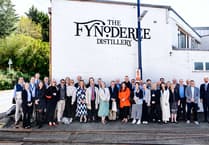The sawmill has turned its fortunes around over recent years from what had been a loss-making operation faced with possible closure.
Investment in integrated sawmilling equipment for the mill and a streamlined product range has helped to transform it into a successful local enterprise.
Lyn Bolton, who is in charge of sales at the sawmill, says: ’A lot of people never knew we were here. Now people are discovering us and coming back.’
The sawmill is an important resource for the island for much for the same reasons that we have our own meat plant and flour mill: to guarantee that we have an on-island supply of a vital commodity.
The need for this has been highlighted by Covid-19 restrictions which have severely affected similar operations in the UK while our own sawmill has survived and thrived.
Lyn says: ’Timber prices in the UK have gone up by 60% but we’re not charging any more.’
All the trees the sawmill uses are grown by the Forestry Directorate in their 7,000 acres of land around the island. It’s all larch and spruce. Forestry do all the planting and harvesting and raw timber is brought to the sawmill, essentially as tree trunks stripped of their branches.
It is then cut to different lengths: one tree might provide three lengths of different widths, from the thickest at the base, getting thinner towards the top.
The bottom part will be cut to 3.8 metre lengths and is used for mill timber.
The mill is virtually completely automated with the process controlled by sawmill supervisor, Billy Maddrell.
He sits in an office high up at one end of the mill with a bank of computer screens. As a large piece of timber is positioned ready for the saw they send a laser light down onto the timber so that Billy, using joysticks, can line it up remotely with perfect accuracy.
When it is fed through the saw, the rounded sides are squared off, one by one leaving a perfectly rectangular length of timber.
Billy says he reckons he can process up to 85 trees a day.
The timber then travels on down the line, to be cut to the correct widths in line with customer orders, a process supervised by John Williamson.
Sawmill manager, Mark Wild, says: ’We’re very proud of our quality. We supply a lot of stuff to the Department of Infrastructure, including timbers for the Queens Pier.’
The remainder of the tree does not go through the mill but is used for agricultural products: the middle part is cut into 2.25 metre lengths and debarked, then used for straining posts, while the upper lengths become split posts.
There’s been a big demand for agricultural products, the start of lockdown coinciding with the busiest time of year for fencing.
Lyn says: ’People were buying like crazy pre-lockdown so all the stocks got really low.
’The staff in the mill came back on May 4 and the sales team two weeks later and we have been really, really busy.’
All the timber, whether milled or used for agricultural purposes, goes through the treatment plant where the wood is pressure treated and tantalised.
This impregnates the timber with a preservative solution under high vacuum pressure in what looks like a huge metal tube. It ensures that the preservative penetrates deep into the timber cells to protect against fungal decay and insect attack.
Steve Clarke, who is charge of the treatment plant, explains: ’The timber goes in and it’s vacuumed for about half an hour then the chamber is flooded and put under pressure for 90 minutes at 180psi then the whole tank is drained and vacuumed again and the wood is stacked in the shed to dry.’
The timber is lifted into the chamber in large bundles by forklift.
Because the mill has been so busy, Steve has been starting an extra treatment cycle at the end of the afternoon and coming back to the mill at 8pm in the evening to take the timber out.
The mill also produces a wide range of finished wood products including fencing panels, sheds and garden furniture.
In the joinery shop Alan Bell and Pip Crellin are working their way through a list of bespoke customer orders from planters and benches to smoking shelters and summerhouses.
It’s a long list, says Alan: ’Everyone’s spending their money on garden stuff these days.’
They even recently made a shed with a bar inside for a customer: ’Show us a picture of what you want and we’ll build it,’ says Lyn.
Almost nothing is wasted at the sawmill.
Every bit of the tree, including sawdust and shavings which go for equine bedding, gets used.
When a tree trunk goes through the mill and the rounded outer sides are sliced off, the waste wood goes to the prison where inmates chop and bag it and it is then returned to the sawmill to be sold as firewood.
Any trees which are unsuitable for milling are reduced to chippings and these are used to feed the giant biomass boiler that heats the sawmill offices and DEFA’s headquarters across the road.
Any waste from the chipping process is sold as garden mulch.
The sawmill sells its products direct to the public and through agricultural suppliers like Sadlers and Cannells and when it comes to their ambitions for the future Lyn says: ’At the moment we can’t supply all the timber these suppliers need, they also have to import some.
’We would love to get to the point where we could supply it all and they didn’t need to import anything.’





Comments
This article has no comments yet. Be the first to leave a comment.